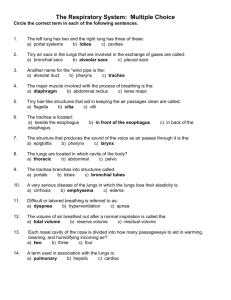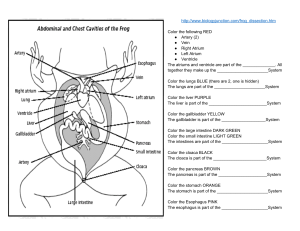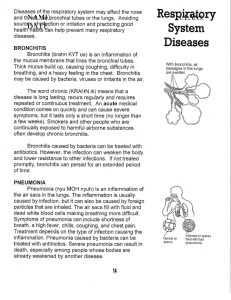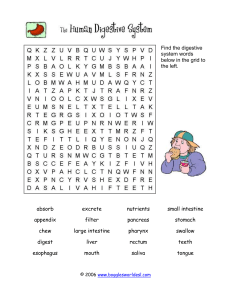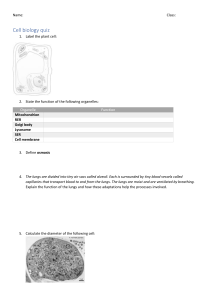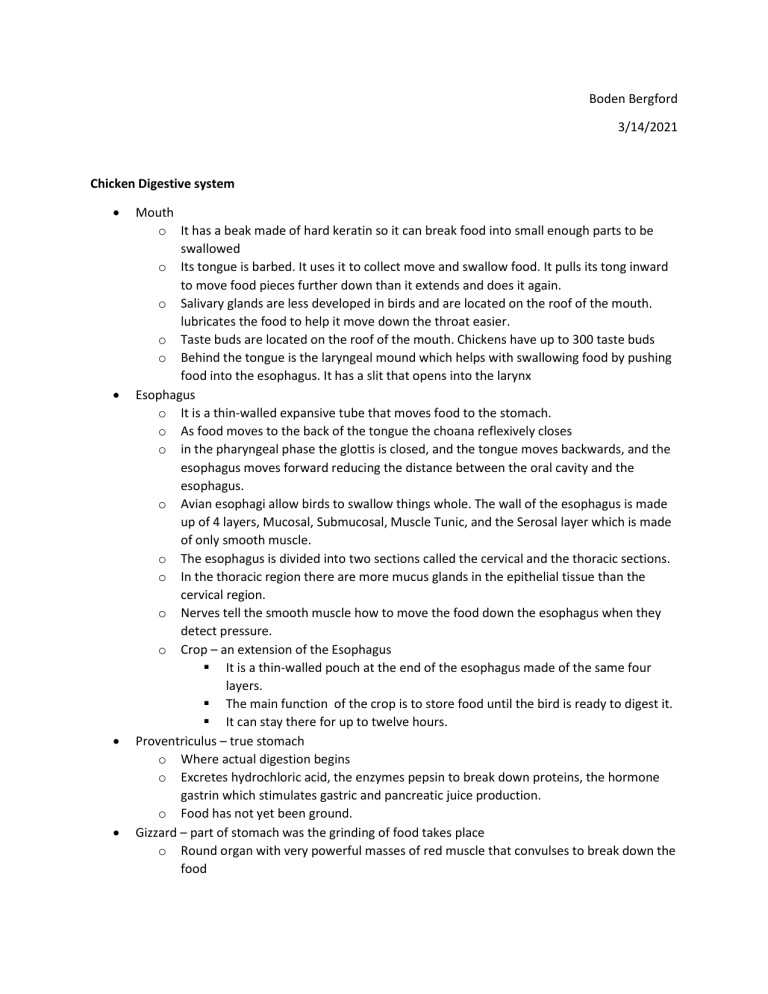
Boden Bergford 3/14/2021 Chicken Digestive system Mouth o It has a beak made of hard keratin so it can break food into small enough parts to be swallowed o Its tongue is barbed. It uses it to collect move and swallow food. It pulls its tong inward to move food pieces further down than it extends and does it again. o Salivary glands are less developed in birds and are located on the roof of the mouth. lubricates the food to help it move down the throat easier. o Taste buds are located on the roof of the mouth. Chickens have up to 300 taste buds o Behind the tongue is the laryngeal mound which helps with swallowing food by pushing food into the esophagus. It has a slit that opens into the larynx Esophagus o It is a thin-walled expansive tube that moves food to the stomach. o As food moves to the back of the tongue the choana reflexively closes o in the pharyngeal phase the glottis is closed, and the tongue moves backwards, and the esophagus moves forward reducing the distance between the oral cavity and the esophagus. o Avian esophagi allow birds to swallow things whole. The wall of the esophagus is made up of 4 layers, Mucosal, Submucosal, Muscle Tunic, and the Serosal layer which is made of only smooth muscle. o The esophagus is divided into two sections called the cervical and the thoracic sections. o In the thoracic region there are more mucus glands in the epithelial tissue than the cervical region. o Nerves tell the smooth muscle how to move the food down the esophagus when they detect pressure. o Crop – an extension of the Esophagus It is a thin-walled pouch at the end of the esophagus made of the same four layers. The main function of the crop is to store food until the bird is ready to digest it. It can stay there for up to twelve hours. Proventriculus – true stomach o Where actual digestion begins o Excretes hydrochloric acid, the enzymes pepsin to break down proteins, the hormone gastrin which stimulates gastric and pancreatic juice production. o Food has not yet been ground. Gizzard – part of stomach was the grinding of food takes place o Round organ with very powerful masses of red muscle that convulses to break down the food o The inner surface is made of a rough ridged keratinized tissue that acts as the “teeth” this is called corallin that helps protect the gizzard form the acids from the stomach o Small rocks help pulverize the food in the gizzard. Small intestine - were digestion and absorption occur o Has 2 sections the Duodenal Loop which is around the pancreas, and the lower small intestine o Hormones are released as food passes through the duodenal loop which tells the pancreas to release enzymes and digestive hormones. This acts to dilute the hydrochloric acid from the stomach. Then enzymes released called trypsin and chymotrypsin break down proteins into amino acids. Amylase breaks down Carbs. Lipase breaks down fat. Insulin and glucagon are released to regulate blood sugar levels. o The gall bladder releases bile from the liver into the Duodenal loop with the rest of the enzymes to continue the digestive process o The Food is now called Chyme as it moves through the small intestine o The small intestine walls are lined with villi which are small flexible protrusions that provide high surface area to absorb more nutrients and remaining products of digestion. Large intestine – Were most water absorption happens Ceca o Two pouches that are located were the small and large intestines join and have tubes extending down to meet the end of the large intestine. o Some of the water remaining in digestive material is absorbed. o Any remaining course remaining coarse materials are broken down here with fermentation. This produces fat and several vitamins for the chicken Cloaca – the main excretory organ o Is located at the end of the large intestine o The ureter leads here in all birds o The reproductive tract also joins at the cloaca in females o Digestive waste and urinary waste mix here and pass out of the vent o The cloaca is also flexible enough to accommodate an egg passing through it. Avian Respiratory System Do not have a muscular diaphragm do intake air must rely on the expansion of the ribcage for negative pressure Fresh oxygenated air enters the lungs as the bird exhales and waste CO2 exits the lungs when it Inhales The respiratory system of a bird is made up of a trachea, relatively small lungs and usually around nine large air sacs Air Sacs – Store extra air to be sent to the lungs or wait to be exhaled o Do not play a role in gas exchange o Allow a continuous stream of air to pass through the lungs in a one-way flow. o Connected to special pneumatic bones to act as radiators to get rid of excess heat o These air sacs include a pair of Cervical Air Sacs, a Interclavicular air sac, two pairs of thoracic air sacs, and a pair of large abdominal air sacs. Path of a breath in an avian respiratory system. o o o o o When the bird inhales the air travels down the trachea and through the bronchi in the lungs to end up in the two pairs of thoracic air sacs and the pair of abdominal air sacs. No gas exchange has occurred even though it passed through the lungs, and the air has only traveled through relatively large tubes at this point. When the bird exhales the rib cage contracts squeezing the air sacs which push air into the lungs through parabronchi that get smaller until it is called air capillaries. These air capillaries flow the opposite direction of the blood capillaries to maximize diffusion of CO2 and oxygen. It does this because the Air is always passing by CO2 rich blood maximizing the diffusion speed. When the bird inhales again the air enters the interclavicular and cervical air sacs When the bird exhales again these sacs contract and travel up the trachea and out the nose. The first and second steps are happening at the same time in when the bird exhales and inhales allowing for the continuous flow of air through the lungs
